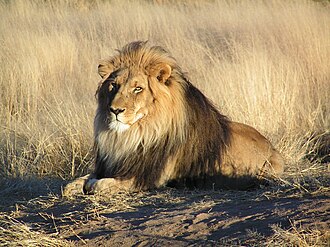Lion
Lion (Panthera leo) is one of the large cats in the genus Panthera and a member of the family Felidae. Commonly referred to as the "king of the jungle," the lion has been a symbol of strength and courage for thousands of years. Despite their nickname, lions primarily live in the grasslands and savannas of Africa, with a small population residing in Gir Forest National Park in India. This article provides an overview of the lion, including its characteristics, behavior, and conservation status.
Characteristics
Lions are the second-largest cats after the tiger, with some males exceeding 250 kg (550 lb) in weight. They exhibit sexual dimorphism; males are distinguishable by their prominent mane, which is absent in females. The mane's color and size vary and are thought to signal the male's fitness to females. Lions have a muscular, deep-chested body, short rounded head, round ears, and a hairy tuft at the end of their tail.
Behavior
Lions are apex predators, although they scavenge when opportunities occur. They typically inhabit savanna and grassland, although they may take to bush and forest. Lions are unusually social compared to other cats. A pride of lions consists of related females and offspring and a small number of adult males. Groups of female lions typically hunt together, preying mostly on large ungulates.
Reproduction and Lifecycle
Female lions reach sexual maturity at about four years of age and males at about five years. The gestation period is about 110 days, and litters can be from one to six cubs. Cubs are born blind and do not open their eyes until approximately a week after birth. They are weaned at about six months of age but remain with their mothers for at least two years.
Conservation Status
The lion is listed as Vulnerable on the IUCN Red List due to habitat loss, human-wildlife conflict, and poaching. The African lion population is estimated to be between 20,000 and 25,000 and is declining. The Asiatic lion (Panthera leo persica), a subspecies that resides in India, is listed as Endangered, with only about 523 individuals remaining in the wild.
Cultural Significance
Lions have been celebrated throughout history for their courage and strength. They are featured in folklore, religion, and mythology across various cultures, including ancient Egypt, where the lioness was regarded as a war deity. The lion continues to be a popular symbol in modern culture, representing authority, dignity, and pride.
See Also
Transform your life with W8MD's budget GLP-1 injections from $125.
W8MD offers a medical weight loss program to lose weight in Philadelphia. Our physician-supervised medical weight loss provides:
- Most insurances accepted or discounted self-pay rates. We will obtain insurance prior authorizations if needed.
- Generic GLP1 weight loss injections from $125 for the starting dose.
- Also offer prescription weight loss medications including Phentermine, Qsymia, Diethylpropion, Contrave etc.
NYC weight loss doctor appointments
Start your NYC weight loss journey today at our NYC medical weight loss and Philadelphia medical weight loss clinics.
- Call 718-946-5500 to lose weight in NYC or for medical weight loss in Philadelphia 215-676-2334.
- Tags:NYC medical weight loss, Philadelphia lose weight Zepbound NYC, Budget GLP1 weight loss injections, Wegovy Philadelphia, Wegovy NYC, Philadelphia medical weight loss, Brookly weight loss and Wegovy NYC
|
WikiMD's Wellness Encyclopedia |
| Let Food Be Thy Medicine Medicine Thy Food - Hippocrates |
Medical Disclaimer: WikiMD is not a substitute for professional medical advice. The information on WikiMD is provided as an information resource only, may be incorrect, outdated or misleading, and is not to be used or relied on for any diagnostic or treatment purposes. Please consult your health care provider before making any healthcare decisions or for guidance about a specific medical condition. WikiMD expressly disclaims responsibility, and shall have no liability, for any damages, loss, injury, or liability whatsoever suffered as a result of your reliance on the information contained in this site. By visiting this site you agree to the foregoing terms and conditions, which may from time to time be changed or supplemented by WikiMD. If you do not agree to the foregoing terms and conditions, you should not enter or use this site. See full disclaimer.
Credits:Most images are courtesy of Wikimedia commons, and templates, categories Wikipedia, licensed under CC BY SA or similar.
Contributors: Prab R. Tumpati, MD






